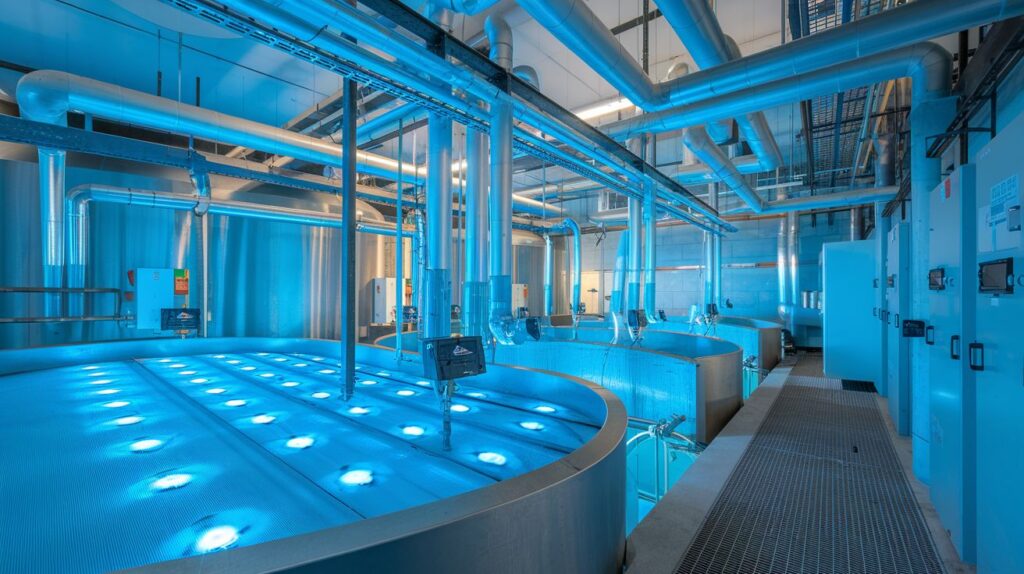Have you ever wondered if there’s a way to purify water without using harsh chemicals? 🤔 Enter UV water purification, a cutting-edge technology that’s revolutionizing how we ensure safe, clean drinking water. This method harnesses the power of ultraviolet light to eliminate harmful microorganisms, providing a chemical-free solution to water treatment.
Imagine having access to crystal-clear, pathogen-free water at the flick of a switch. UV water purification makes this a reality, offering numerous benefits over traditional methods. From its eco-friendly nature to its ability to tackle even chlorine-resistant microbes, this technology is quickly becoming a go-to choice for both residential and industrial applications.
In this blog post, we’ll dive deep into the world of UV water purification. We’ll explore how it works, uncover its many advantages, and guide you through choosing the right system for your needs. Whether you’re a homeowner looking to improve your water quality or a business owner seeking efficient water treatment solutions, you’ll find valuable insights in the sections that follow. Let’s shed some light on this brilliant purification method! 💧✨
Understanding UV Water Purification
Definition of UV water purification
UV water purification is a cutting-edge method that uses ultraviolet (UV) light to disinfect water by inactivating harmful microorganisms. This process effectively eliminates bacteria, viruses, and other pathogens without the use of chemicals, making it an environmentally friendly and efficient water treatment solution.
| Feature | Description |
|---|---|
| Technology | Ultraviolet light |
| Target | Microorganisms |
| Method | DNA disruption |
| Chemical-free | Yes |
| Residual effect | No |
Historical development of UV technology
The use of UV light for water purification dates back to the early 20th century:
- 1910: First use of UV lamps for disinfection in Marseille, France
- 1916: Implementation in the U.S. for drinking water treatment
- 1950s-1960s: Advancements in UV lamp technology
- 1980s-1990s: Widespread adoption in municipal water treatment
- 2000s-present: Refinement of UV LED technology for more efficient systems
Types of UV water purification systems
UV water purification systems come in various configurations to suit different needs:
- Point-of-Entry (POE) systems: Installed at the main water line
- Point-of-Use (POU) systems: Installed at specific water outlets
- Portable UV purifiers: For travel or emergency use
- UV-LED systems: Energy-efficient and mercury-free alternative
Each type offers unique advantages, catering to diverse applications from residential use to large-scale industrial water treatment. As we explore the science behind UV water purification, we’ll gain a deeper understanding of how these systems effectively eliminate waterborne pathogens.
The Science Behind UV Water Purification
UV light spectrum and germicidal properties
UV light is divided into three main categories: UV-A, UV-B, and UV-C. Among these, UV-C light (wavelengths between 200-280 nm) is most effective for water purification due to its germicidal properties. The optimal wavelength for inactivating microorganisms is around 254 nm.
| UV Type | Wavelength Range | Germicidal Effectiveness |
|---|---|---|
| UV-A | 315-400 nm | Low |
| UV-B | 280-315 nm | Moderate |
| UV-C | 200-280 nm | High |
How UV-C light inactivates microorganisms
UV-C light penetrates the cell walls of microorganisms and disrupts their DNA or RNA structure. This process, known as thymine dimerization, prevents the organisms from reproducing and effectively renders them harmless.
Effectiveness against various pathogens
UV water purification is highly effective against a wide range of pathogens, including:
- Bacteria (e.g., E. coli, Salmonella)
- Viruses (e.g., Hepatitis, Rotavirus)
- Protozoa (e.g., Giardia, Cryptosporidium)
- Algae and fungi
Factors affecting UV purification efficiency
Several factors can impact the effectiveness of UV water purification:
- Water quality (turbidity, color, dissolved solids)
- UV light intensity and exposure time
- Flow rate of water through the system
- Lamp age and maintenance
- Temperature and pH of the water
Now that we understand the science behind UV water purification, let’s explore the actual process involved in this method of water treatment.
UV Water Purification Process
Key components of a UV purification system
A UV water purification system consists of several essential components:
- UV lamp
- Quartz sleeve
- Reactor chamber
- Control panel
- Sensors
| Component | Function |
|---|---|
| UV lamp | Emits UV-C light to inactivate microorganisms |
| Quartz sleeve | Protects the UV lamp from water contact |
| Reactor chamber | Houses the UV lamp and allows water flow |
| Control panel | Monitors and controls system operations |
| Sensors | Detect water flow and UV intensity |
Step-by-step breakdown of the purification process
- Water enters the reactor chamber
- UV-C light emitted by the lamp penetrates microorganisms
- DNA/RNA of pathogens is disrupted, preventing reproduction
- Treated water exits the chamber
Integration with other water treatment methods
UV water purification often complements other treatment techniques:
- Pre-filtration: Removes larger particles before UV treatment
- Activated carbon filtration: Improves taste and odor
- Reverse osmosis: Removes dissolved solids and chemicals
This multi-barrier approach ensures comprehensive water purification, addressing various contaminants and providing safe, clean drinking water. UV purification plays a crucial role in this integrated system by effectively neutralizing harmful microorganisms without adding chemicals or altering water composition.
Benefits of UV Water Purification
Chemical-free disinfection
UV water purification offers a chemical-free approach to water disinfection, setting it apart from traditional methods. Unlike chlorine or other chemical treatments, UV light effectively eliminates harmful microorganisms without introducing any additives to the water. This results in pure, clean water without the risk of chemical byproducts or residual taste.
Effective against chlorine-resistant microorganisms
One of the key advantages of UV water purification is its ability to neutralize chlorine-resistant pathogens. Microorganisms like Cryptosporidium and Giardia, which can survive chlorine treatment, are effectively inactivated by UV light. This table illustrates the effectiveness of UV purification against various pathogens:
| Pathogen | UV Effectiveness |
|---|---|
| Bacteria | High |
| Viruses | High |
| Protozoa | High |
| Algae | Moderate |
Low maintenance and operating costs
UV water purification systems are known for their cost-effectiveness in the long run. Benefits include:
- Minimal energy consumption
- No need for chemical replenishment
- Simple maintenance procedures
- Long-lasting UV lamps (typically 9-12 months)
Environmentally friendly solution
UV water purification is an eco-friendly option for water treatment. It doesn’t produce harmful byproducts or introduce chemicals into the environment. This method aligns well with sustainable water management practices, making it an excellent choice for environmentally conscious consumers and businesses.
Improved taste and odor of water
By eliminating chlorine and other chemical treatments, UV purification helps maintain the natural taste and odor of water. This results in more refreshing and palatable drinking water, free from the chemical aftertaste often associated with other purification methods.
Now that we’ve explored the benefits of UV water purification, let’s examine its various applications across different sectors and industries.
Applications of UV Water Purification
Residential use
UV water purification systems have become increasingly popular in homes, offering a chemical-free solution for clean drinking water. These compact units are easy to install and maintain, making them ideal for:
- Kitchen sinks
- Whole-house water treatment
- Well water disinfection
| Feature | Benefit |
|---|---|
| Compact size | Fits under sink or in utility room |
| Low maintenance | No chemicals to replace |
| Energy-efficient | Uses minimal electricity |
Commercial and industrial applications
UV technology plays a crucial role in various industries, ensuring water safety and quality:
- Food and beverage production
- Pharmaceutical manufacturing
- Aquaculture and fish farming
- Cooling towers and HVAC systems
Municipal water treatment
Many cities incorporate UV water purification into their treatment processes, complementing traditional methods:
- Pre-treatment before chlorination
- Final disinfection step
- Wastewater treatment and recycling
Developing countries and emergency situations
UV water purification offers a lifeline in areas lacking clean water infrastructure:
- Portable UV devices for travelers
- Community-scale systems in rural areas
- Disaster relief efforts
UV water purification’s versatility makes it invaluable across various sectors. From ensuring safe drinking water in homes to maintaining hygiene standards in industries, its applications are far-reaching. As we move forward, let’s explore some limitations and considerations to keep in mind when implementing UV water purification systems.
Limitations and Considerations
Pre-treatment requirements
Before implementing UV water purification, it’s crucial to understand the necessary pre-treatment steps. These requirements ensure the system’s effectiveness and longevity:
- Sediment filtration: Removes particles that can shield microorganisms from UV light
- Carbon filtration: Eliminates organic compounds and improves water clarity
- Water softening: Reduces mineral buildup on UV lamps
| Pre-treatment Step | Purpose | Importance |
|---|---|---|
| Sediment filtration | Particle removal | High |
| Carbon filtration | Organic compound elimination | Medium |
| Water softening | Mineral reduction | Low to Medium |
Water quality factors
The effectiveness of UV water purification depends on several water quality factors:
- Turbidity: High turbidity can reduce UV light penetration
- Iron content: Excessive iron can cause staining on UV lamps
- Hardness: Hard water can lead to scale formation on quartz sleeves
- UV transmittance: Lower transmittance requires higher UV dosage
Power dependency
UV water purification systems rely on a constant power supply:
- Requires uninterrupted electricity for continuous disinfection
- Power outages can compromise water safety
- Backup power sources may be necessary for critical applications
Lack of residual disinfection
Unlike chemical treatments, UV purification doesn’t provide lasting protection:
- Disinfection occurs only at the point of treatment
- No residual effect in distribution systems
- May require additional measures for long-term storage
While UV water purification offers numerous benefits, these limitations highlight the importance of proper system design and maintenance. Next, we’ll explore how to choose the right UV water purification system for your specific needs.
Choosing the Right UV Water Purification System
Factors to consider when selecting a system
When choosing a UV water purification system, several key factors should be taken into account:
- Water quality
- Flow rate
- UV dose
- Lamp life
- Control features
| Factor | Importance |
|---|---|
| Water quality | Determines pre-treatment needs |
| Flow rate | Ensures system meets household demand |
| UV dose | Guarantees effective disinfection |
| Lamp life | Affects maintenance frequency |
| Control features | Enhances system monitoring and operation |
Sizing and capacity requirements
Proper sizing is crucial for optimal UV water purification performance. Consider:
- Daily water consumption
- Peak flow rate
- Number of water outlets
- Future expansion needs
Maintenance and replacement schedules
Regular maintenance is essential for UV system efficiency:
- Clean quartz sleeve quarterly
- Replace UV lamp annually
- Change pre-filters as needed (typically every 3-6 months)
- Monitor system performance with UV intensity sensors
Cost considerations
When evaluating UV water purification systems, factor in:
- Initial equipment cost
- Installation expenses
- Ongoing operational costs (electricity, lamp replacements)
- Maintenance requirements
Compare long-term costs with other purification methods to determine the most cost-effective solution for your needs. With these factors in mind, you’ll be well-equipped to select the right UV water purification system for your home or business.

UV water purification stands out as a powerful and efficient method for ensuring clean, safe drinking water. By harnessing the power of ultraviolet light, this technology effectively eliminates harmful microorganisms without the use of chemicals or altering water taste. Its wide range of applications, from residential use to industrial settings, makes it a versatile solution for various water treatment needs.
As we continue to face global water challenges, UV water purification offers a promising path forward. Whether you’re considering a system for your home or evaluating options for a larger-scale application, understanding the science, benefits, and limitations of UV purification is crucial. By making informed decisions about water treatment, we can contribute to better health outcomes and environmental sustainability for ourselves and future generations.



